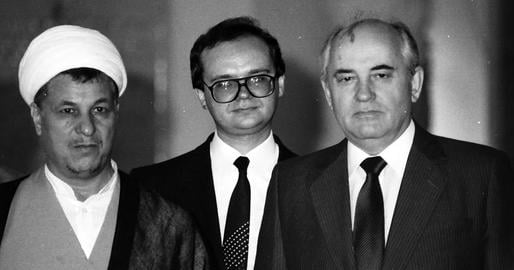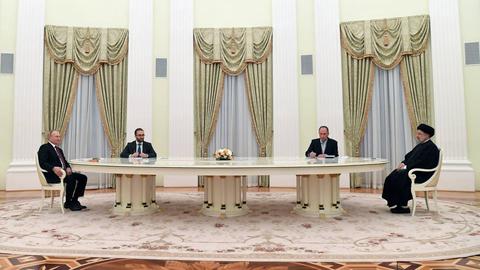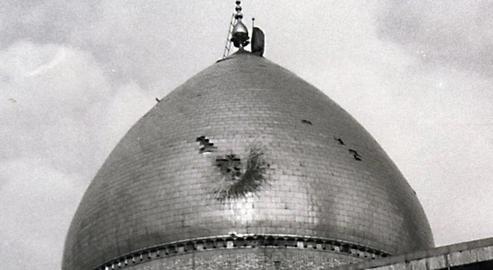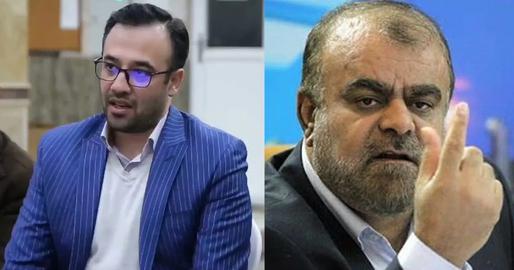Mikhail Gorbachev, the last leader of the Soviet Union, died on August 30 at the age of 92. After the 1979 revolution in Iran, Gorbachev was the only Soviet figurehead to establish relations with the Islamic Republic of Iran.
During his leadership in 1989, in an unprecedented gesture, Gorbachev received Akbar Hashemi Rafsanjani – then the speaker of the Iranian parliament – and treated him as if he were the president of Iran, selling him a cache of weapons in what is today still considered the biggest arms sale to Iran post-Islamic Revolution.
The following is a glimpse of Tehran-Moscow relations in that tumultuous decade, based on Rafsanjani’s diaries from 1986 to 1971. In his own telling at least, Rafsanjani appears to have strained to preserve good relations - and closed the deal despite last-minute obstacles - after a slight on Moscow by Iran's ageing then-Supreme Leader Ayatollah Khomeini.
Part I: Khomeini’s Famous Letter
If Iranians remember Mikhail Gorbachev for anything aside from the breakup of Soviet Union it would probably be the letter sent to him by Ayatollah Ruhollah Khomeini, warning him that the bloc was on the brink of collapse.
This was Khomeini’s only written message to a foreign leader. Contrary to all expectations given its presumptuous content, it played a historical role in bringing the two countries closer together.
Khomeini’s message was sent to Moscow and delivered to Gorbachev on January 3, 1989 by a delegation comprising Abdollah Javadi-Amoli, a high-level cleric in Qom, Foreign Minister Mohammad-Javad Larijani, and Marzieh Hadidchi, a member of Khomeini’s staff.
A fortnight earlier, on December 2, 1988, Khomeini had told a handful of officials close to him in Iran, including Akbar Hashemi Rafsanjani, that he was planning to write to the leader of the Soviet Union to this effect.
“We were evening guests of Mr. Ahmad [Khomeini’s son],” wrote Rafsanjani in his diary. “Mr. [Ali] Khamenei was there, too. We talked about the current affairs of the country. Imam [Khomeini] was present at the meeting as well. He was in very good health. He said he was thinking of writing a letter to Mr. Gorbachev.”
When Khomeini did put pen to paper, however, Rafsanjani feared the text of it would rub Gorbachev up the wrong way. “I went to the meeting of the heads of the branches of power in the office of [then President] Ayatollah Khamenei,” he wrote in his diary for December 17. “Mr. Ahmad had brought the text of Imam’s letter to Gorbachev for consultations. It was a good letter but it might offend.”
The following day, Rafsanjani got himself together and spoke to Khomeini about it. “I worked in my office until eight at night. Then I returned home. I talked on the phone with Mr. Ahmad about the letter to Gorbachev. I suggested the tone of it be such that it will not offend them.”
The remarks were not entirely heeded. Khomeini's final letter suggested in light of the apparent failure of the communist project, Gorbachev follow the Islamic model instead. "Mr. Gorbachev!" he wrote. "Marxism is a materialistic ideology and materialism cannot bring humanity out of the crisis caused by a lack of belief in spirituality, the prime affliction of the human society in the East and the West alike... Your problem is the absence of true faith in God."
Later entries in Rafsanjani’s diary show that after Gorbachev replied, senior officials in the Islamic Republic held a meeting just to scrutinize the contents. Of just as much note, however, was the manner in which Khomeini received the formal response, which was conveyed to Tehran by Soviet Foreign Minister Eduard Shevardnadze.
Unlike his successor, Ayatollah Khomeini actually did meet in person with the foreign ministers of other countries. In his meeting with Shevardnadze, however, something odd happened. As the Soviet foreign minister was reading Gorbachev’s written response, Khomeini stood up, said irritably that he had only meant to give Gorbachev some advice, and left the room.
Part of the meeting was captured on film, and a picture exists of this moment showing a flabbergasted Soviet foreign minister left standing there with the letter, whole others in the room look baffled.
Part II: The Invitation
On February 27, 1989, Hashemi Rafsanjani, as both the influential speaker of the Iranian parliament and a powerful official in his own right, met with the Soviet Foreign Minister. “The Soviet Foreign Minister Shevardnadze came,” he wrote of the meeting. “He expressed his satisfaction with Imam’s message and with his meeting with Imam, even though when he was talking Imam had said ‘This is not what I meant; I wanted to open the doors to a different world for Mr. Gorbachev’ and had stood up unhappily.
“But later, he [Shevardnadze] was happy with how the news of it had been aired. He earnestly espoused the expansion of relations, for the Americans to leave the Persian Gulf, and for a resolution to the issue of Afghanistan. I agreed with him. He gave me an invitation from Gorbachev to visit Russia. I accepted, and said the foreign ministers [of the two countries] should set the date for the visit.”
At the time, Rafsanjani’s brother Mohammad Hashemi was president of Islamic Republic of Iran Broadcasting (IRIB). From Rafsanjani’s diaries it is clear that he had carried out his own brother’s orders to give the awkward meeting between Khomeini and Shevardnadze a positive spin.
According to Rafsanjani, Shevardnadze then also asked for a private meeting with him: “I agreed. We talked in the presence of the interpreter and [Foreign Minister] Dr. Velayati. He told Mr. Velayati that he would discuss the armaments deal when he returns to Moscow.”
Ayatollah Khomeini’s treatment of Gorbachev’s special envoy to Tehran was far from diplomatic but Gorbachev disregarded it and maintained close relations via Hashemi Rafsanjani. This, too, came at a time when Iran’s ruling establishment was in a crisis. Khomeini’s health had deteriorated and Ayatollah Hossein Ali Montazeri had been dismissed as the deputy Supreme Leader and Khomeini’s heir apparent. Rafsanjani continued his communication with Gorbachev through this turbulence, where normally it would have been the responsibility of then-President Ali Khamenei.
On April 4, 1989, Rafsanjani wrote that Foreign Minister Velayati had returned from his visit to Moscow and reported back to him about it. “Gorbachev and Shevardnadze had been very cordial and declared their readiness to cooperate on military, economic and political affairs. They have deferred the final decision until I visit the Soviet Union. They believe that June would be a good time for the visit.”
The visit by the speaker of parliament to Moscow did not happen while Khomeini was still alive. Rafsanjani finalized the schedule for his visit before he ran for the presidency. It made no odds as far as Moscow was concerned; like the Iranian public, Soviet officials were certain Rafsanjani was going to be the next president of the Islamic Republic.
Just two weeks after Ayatollah Khomeini’s death, Hashemi Rafsanjani prepared himself for his important visit to Moscow and to sign the biggest purchase of arms and military equipment Iran had made since the 1979 revolution: a contract whose magnitude was kept secret even from most officials in Tehran.
“Commanders of the army and the Revolutionary guards, the chiefs of staff and [officials of] the ministries, came to discuss and evaluate negotiations with Russians for purchasing armaments.,” Rafsanjani reported. “Mr. Mahmoud Vaezi [deputy foreign minister] and brought me the draft for my speech at the dinner table at Gorbachev’s banquet. I reviewed the speech and made revisions.”
Part III. The Visit to Moscow
One day later on June 20, 1989, while Iran was still in mourning for Ayatollah Khomeini, Rafsanjani departed for Moscow. “With an official sendoff,” he wrote, “we took off for Moscow at 11am. Another plane had taken our companions ahead of us. Our delegation, a combination of government, parliament and military [officials] is very large because of the sheer number of topics on the agenda… We consulted and conferred on the plane... We watched the landscape of mountains, farms and water while flying over Soviet soil.”
Hashemi Rafsanjani and his entourage landed at a special hangar for guests of the state, south of Moscow: “As was scheduled, Koliakov, Gorbachev’s first deputy, the foreign minister [Shevardnadze] and a group of Soviet officials welcomed us at the airport. Review and parade ceremonies were held. I was told it was like welcoming heads of state. We departed for the Kremlin directly from the airport.”
At the Kremlin, Mikhail Gorbachev personally welcomed the speaker of the Iranian parliament: “The first encounter was warm and cordial. Photographers and cameramen were taking pictures and filming. Official negotiations started immediately in one of halls with the participation of a group of my companions and Soviet officials.
“The negotiations were general, friendly and productive. Then we had a private meeting in the presence of foreign ministers, our ambassador, and an interpreter for both sides. In this private meeting, the negotiations were on political, technological, economic and military issues, and were also forthright and genial. The two meetings lasted a total of two hours and both sides were happy.”
During this visit, for the first time Gorbachev allowed the Iranian delegation to visit a Muslim region of the Soviet Union: Baku, the capital of soviet Azerbaijan. According to Rafsanjani, the Soviet Union had previously rejected such a request.
Nor was this the highlight of Rafsanjani’s visit to the Soviet Union. On June 21, 1989, Iran and Soviet Union signed an important contract at Kremlin.
Part IV: The Armaments Deal
Hashemi Rafsanjani wrote in his diary that he woke up at 4am to read the newly-drafted cooperation agreement with the Soviet Union that was to last until the year 2000. He had just a few hours in which to sign it.
“I had breakfast with the family in our residence,” he wrote. We went to visit the tomb of the unknown soldier next to the Kremlin’s wall. They were holding a military ceremony there. We laid a wreath. Earlier they had hinted that they wanted us to do this ceremony at Lenin’s tomb but we could not agree to that, because of certain considerations.
“Mr. Dikov’s explanation about the Soviet-US agreement to destroy missiles [the 1987 Intermediate-Range Nuclear Forces Treaty] was interesting and strange to me. Again we went to the Kremlin. We had two consecutive meetings with Gorbachev. The first one was public and was for putting together the results of the committees’ negotiations. It was productive. The second was private, and was for evaluating these results in aid of cooperation on armaments and defense.
“They were happy to tell us that their politburo had agreed to give us whatever we asked for: MIG-29s, SAM 5 missiles, T-80 tanks, sea-to-sea missiles...In the afternoon we rested a little bit and once again left for the Kremlin to attend Mr. Gorbachev’s dinner banquet.”
Hashemi Rafsanjani wrote that the Russians had asked him to keep the purchase of military equipment from the Soviet Union a secret “because it seemed they were under pressure from the West”.
He went on: “At the dinner table we had a friendly talk with Gorbachev. Both of us delivered a speech. He read the speech from a text, but I made one without. A text had been prepared but they had only distributed the Russian translation, not the Persian. An example of how clumsy our diplomats are.”
The treaty between the Islamic Republic of Iran and the Soviet Union was signed on June 22, 1989 – albeit rather more hastily than planned, back at the airport. “In a special ceremony, Mr. Gorbachev and I signed two agreements,” Rafsanjani wrote. “Then we signed two more with Messrs. [Mohammad Javad] Iravani [Iran’s Minister of Economic Affairs and Finance], Konstantin Katushev [ Soviet Minister of Foreign Economic Relations] and Nikolai Konarev [Soviet Minister of Transportation]. The agreement on the armaments was to be signed by Mr. [Behzad] Nabavi [Iran’s Minister of Heavy Industries] and Mr. Katushev, but it was not ready because of their differences of opinion. After Gorbachev and I insisted, they went and prepared it and signed it at the airport.”
Hashemi Rafsanjani later wrote that to prevent its disclosure, this secret agreement was approved not by the Iranian parliament but only by members of the unelected Expediency Discernment Council, an open violation of the Islamic Republic’s constitution.
Hashemi Rafsanjani’s diaries make no mention of the volume of the armaments purchased from the Soviet Union. No matter how many MIG-29s, T-80 tanks, SAMs and sea-to-sea missiles were purchased, it was the most important acquisition of military technology by the Islamic Republic until then and perhaps even as of now.
visit the accountability section
In this section of Iran Wire, you can contact the officials and launch your campaign for various problems































comments